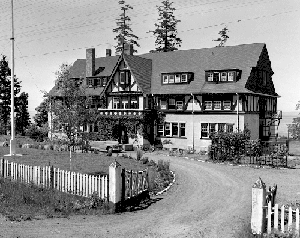Qualicum College

Qualicum College was the most westerly private school in Canada. Founded in 1935, it was established "in the conviction that with the background of a good home, the comradeship of boarding school enables boys to enjoy the happiest kind of childhood and youth, and provides them with the finest preparation for life."
The school overlooking Qualicum Beach on Vancouver Island was modelled on the prestigious "public schools" of Britain. Its philosophy was mens sano in corpore sano ["a healthy mind in a healthy body]" and its aim was to inculcate in boys the virtues of Godliness and good-learning. Though never as large as some of the other independent schools in British Columbia, Qualicum College was widely-known and respected nonetheless, as evidenced by the number of students it attracted from Western Canada, the North Western United States, and the Orient.
Robert Ivan Knight, the founder and headmaster of Qualicum College, was born in 1901 in Calcutta where his father was Director of Public Instruction for Bengal. As was the custom among the Anglo-Indian community, he was sent to England at an early age and was raised in his family home at Camberly. He then attended Oundle, a small but distinguished public school in Northampstonshire. The headmaster of Oundle was the celebrated educationalist and reformer, F.W. Sanderson. Mr. Knight was greatly impressed and influenced by Sanderson's teachings, and the latter's theories on education (especially with regard to the study of science in the public schools) were later incorporated in the Qualicum College curriculum.
Mr. Knight continued his education at Sidney Sussex College, Cambridge, where he took a degree in Sciences. Because of weak eyesight, however, he was unable to pursue a career in scientific research; in fact, on coming down from Cambridge, he was advised to refrain from intensive reading for at least a year. Accordingly, in 1925 he decided to join a cousin who had a "chicken ranche" at Errington, near Parksville, on Vancouver Island. He stayed there until 1927, when he joined C.W. Lonsdale's staff at Shawnigan Lake School. Two years later he enrolled at The University of British Columbia, where he completed an Honours B.A. and a Diploma course in Education.
Despite the onset of the Depression, Mr. Knight resolved to open an independent, fee-paying boarding school in the village resort of Qualicum Beach. With the assistance of Aubrey Dashwood Muskett --former headmaster of the Collegiate School in Victoria -- the school was duly opened in September 1935.
The Qualicum Beach School, as the academy was first known, had nine students and was located in a rented house during its inaugural year. Thanks to financial support from his family in England, Mr. Knight was able to expand his programme, and in 1937 the school was relocated in a handsome, specially-designed building amid 17 acres of seaside property. The headmaster also received assistance from his younger brother, George Henry Knight, who came to the college to teach History, languages, and music. The two brothers formed a partnership and the school (renamed Qualicum College in 1949) was incorporated as a limited liability company.
The college grew steadily and by the early 1960s it had an enrollment of about seventy students, most of whom were boarders. But towards the end of the decade, operational costs increased and enrollment figures began to decline. The social climate had also changed, and the headmaster was increasingly uncomfortable with the youth culture of the Age of Aquarius. So, in 1970 the Knights decided to close the college and sell the college property.
The playing fields were subsequently subdivided for a housing estate, while the Tudor-style main building was purchased by a group of financiers, who transformed the generation-old boarding school into the Qualicum College Inn.
In 1982, Mr. Knight donated records relating the school to the British Columbia Archives. The records include notes, correspondence, reports and other files which document all facets of the day-to-day operations of this school. The collection is catalogued as Add. MSS. 1327.

